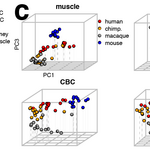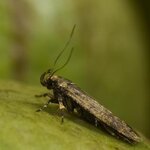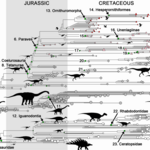Evolution

If you are an organic farmer, you may be worried your crops can be "contaminated" by a field genetically modified with a gene to express a natural toxin against pests. Nasty weeds sometimes evolve directly from natural crosses between domesticated species and wild relatives. A rare plant is threatened due to its small population size and restricted range.
What do all these situations have in common? They illustrate the important role of gene flow among populations and its potential consequences. Gene flow has been recognized as a significant evolutionary force since the 1940s but its…

Though we share superficial physical similarities, the cognitive differences between humans and our closest living cousins, the chimpanzees, are obvious - we metaphorically throw feces at each other while they do it literally. We have been able to use our superior mental abilities to construct civilizations and manipulate our environment to our will, allowing us to take over our planet and walk on the moon while the chimps grub around in a few remaining African forests.
There is no "Planet of the Apes" reality happening no matter how much genetically modified food they eat. Strength is not…

Sorry Australia, you can no longer lay claim to the origins of the iconic New Zealand kiwi - the kiwi's closest relative is not the emu.
Instead, the diminutive kiwi is most closely related to the extinct Madagascan elephant bird – a 2-3 meter tall, 275 kg giant. And surprisingly, a new study in Science concluded, both of these flightless birds once flew.
A new study by the University of Adelaide's Australian Centre for Ancient DNA (ACAD), has solved a 150-year-old evolutionary mystery about the origins of the giant flightless "ratite" birds, such as the emu and ostrich, which are found…

Whether an insect will have a male or female offspring depends on the weather and temperature, according to a study led by Joffrey Moiroux and Jacques Brodeur of the University of Montreal's Department of Biological Sciences.
As part of this study, which was funded by the Ouranos Consortium, Moiroux tried to understand the possible role of global warming on the relationship between crop pests and their natural enemies – parasitoids and predators. Among the issues addressed, he sought to determine whether there is an effect of "phenological asynchrony" between parasitoids and their hosts, and…

In Lewis Carroll's 1871 classic novel Through the Looking Glass, the Red Queen tells Alice: "Now, here, you see, it takes all the running you can do, to keep in the same place."
Over the years, evolutionary biologists have used the Red Queen's statement to refer to the "Red Queen" hypothesis, which describes how living organisms, including humans, manage to survive in a changing environment by adapting through sexual reproduction. According to a University of Iowa researcher, the hypothesis is supported.
In a new paper, lead author Deanna Soper, assistant professor at Beloit College and…

An international team has discovered what happens on a molecular basis to insects that evolved resistance to genetically modified cotton plants.
Their findings shed light on how the global caterpillar pest called pink bollworm overcomes biotech cotton, which was designed to make the organic insect-killing bacterial protein called Bt toxin. The results could have major impacts for managing pest resistance to Bt crops.
Based on laboratory experiments aimed at determining the molecular mechanisms involved, scientists knew that pink bollworm could evolve resistance against the Bt…

Most dinosaurs went extinct 65 million years ago but one dinosaur lineage survived and lives on today – we call these the birds and they rule the skies the way they once ruled land.
An international team, led by scientists from Oxford University and the Royal Ontario Museum, estimated the body mass of 426 dinosaur species based on the thickness of their leg bones. The team found that dinosaurs showed rapid changes in body size shortly after their origins, around 220 million years ago.
However, these soon slowed: only the evolutionary line leading to birds continued to change size…

Take a muscle cell, modify it over millions of years, and you can end up with a shocking evolutionary result: the electric fish.
Electric fish have evolved several times in varying levels of complexity. Two groups of electric fish, one in Africa (Mormyroids) and one in South America (Gymnotiforms), have independently evolved sophisticated communication systems using these cells. By emitting and sensing weak electrical signals, the fish have bypassed the usual means of communication, such as with sounds and visual signals, and go directly to electrical signals.
This allows them to quietly "…

A new report in Molecular Systems Biology speculates about how primitive cells learned to synthesize their organic components – the molecules that form RNA, lipids and amino acids. The paper also suggests an order for the sequence of events that led to the origin of life.
A simulated reconstruction of Earth's earliest ocean in the laboratory revealed the spontaneous occurrence of the chemical reactions used by modern cells to synthesize many of the crucial organic molecules of metabolism. Previously, it was assumed that these reactions were carried out in modern cells by metabolic…

Man or woman? Male or female?
Modern sociological woo about gender aside, in humans and other mammals, the difference between the sexes depends on one single element of the genome: the Y chromosome. It is present only in males, where the two sexual chromosomes are X and Y, whereas women have two X chromosomes. Thus, the Y is ultimately responsible for all the morphological and physiological differences between males and females.
But this has not always been the case.
Once upon a time, the X and Y were identical, until the Y started to differentiate from the X in males. The Y chromosome,…